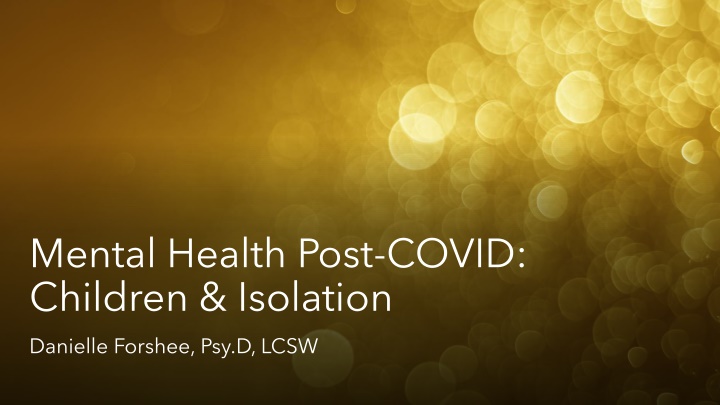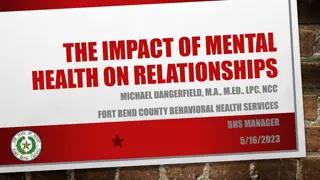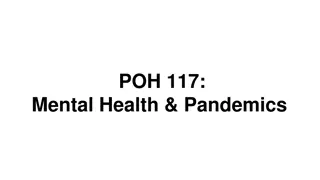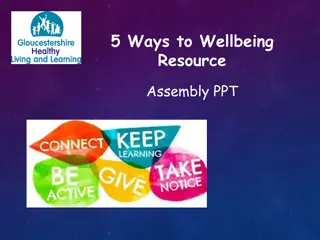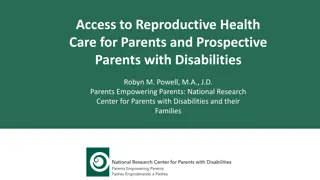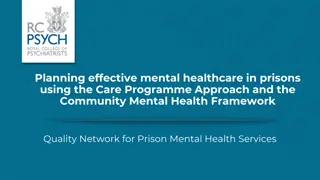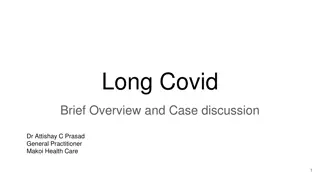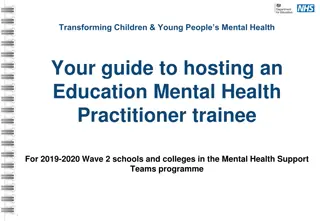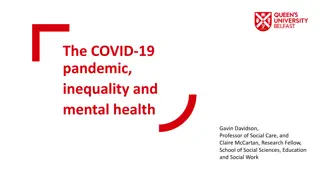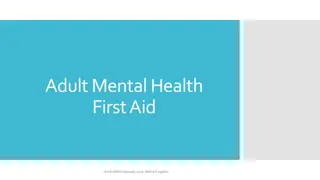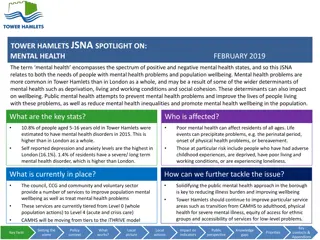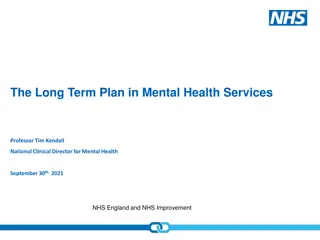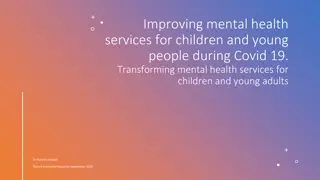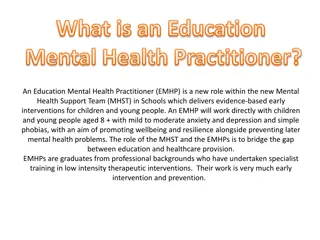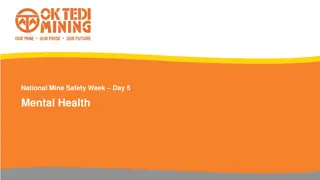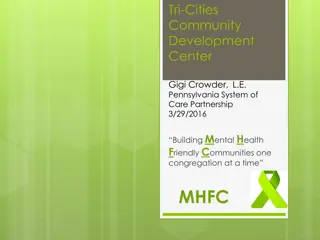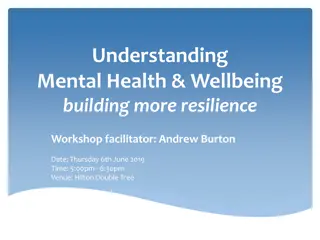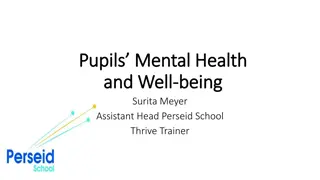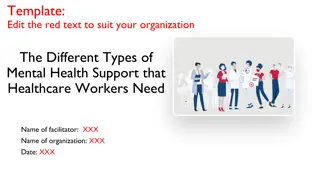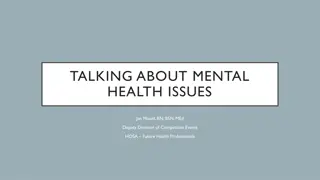Supporting Children's Mental Health Post-COVID: Strategies for Parents
Help children cope with pandemic-related anxieties by providing clarity, encouraging open dialogue, and practicing empathy. Understand and address their concerns to promote emotional well-being during uncertain times.
Download Presentation

Please find below an Image/Link to download the presentation.
The content on the website is provided AS IS for your information and personal use only. It may not be sold, licensed, or shared on other websites without obtaining consent from the author.If you encounter any issues during the download, it is possible that the publisher has removed the file from their server.
You are allowed to download the files provided on this website for personal or commercial use, subject to the condition that they are used lawfully. All files are the property of their respective owners.
The content on the website is provided AS IS for your information and personal use only. It may not be sold, licensed, or shared on other websites without obtaining consent from the author.
E N D
Presentation Transcript
Mental Health Post-COVID: Children & Isolation Danielle Forshee, Psy.D, LCSW
Outline 1. Providing Some Certainty for the Uncertain 2. Speaking to Youngsters about Pandemic Related Anxieties 3. Rational Emotive Behavioral Techniques & COVID 4. Case Illustration 5. From Avoidance to Action 6. Tips & Additional Strategies for Pandemic-Related Anxieties Forshee, 2021
Providing Some Certainty for the Uncertain Youngsters may misinterpret what they hear and are frightened about things they don t understand Provide information that is truthful and appropriate for the youngster s age and developmental stage. Don t offer more information than the child is interested in. If you don t know the answer, it s okay to say you don t know Forshee, 2021
Providing Some Certainty for the Uncertain Explain anxiety to youngsters in a developmentally appropriate manner. This can sound something like, Anxiety is a very natural human emotion that is there to protect us when we need protecting. It s part of being human and we all have it. When our brain senses we might be in a situation that is uncertain, scary or challenging, it causes us to experience anxious feelings. Without anxiety, we would take unnecessary risks. Anxiety is not a bad feeling. It s one we all learn to manage Teach everyday actions of things that are within their control (hand washing, etc.) Forshee, 2021
Speaking to Youngsters about Pandemic- Related Anxieties Be Curious Be Curious Probe for hidden concerns. Ask the youngster, If I were to ask kids your age to list their top three worries, what do you think their answers would be ? Inquire about the youngster s concern(s) more directly by asking something to the effect of, Your mom/dad said you ve been feeling {insert feeling here} about going back to school and playing outside with your friends. Tell me more about that Forshee, 2021
Speaking to Youngsters about Pandemic-Related Anxieties Accept, Listen & Empathize Accept, Listen & Empathize Accept and respect all of the youngsters feelings. Listen quietly and attentively while being non-judgmental. Be mindful your body language is consistent with being actively engaged (eye contact, nodding your head on occasion, turn toward the youngster) Empathize by saying something to the effect of, It must be hard for you to relax/feel safe when you get so worried about things Forshee, 2021
Speaking to Youngsters about Pandemic- Related Anxieties Parents do not have to accept all of the youngster s actions or behaviors, just the feelings. For example, the youngster can tell the parent how upset they are, but he/she is not permitted to express upset by {insert observable behavior here} Forshee, 2021
Speaking to Youngsters about Pandemic- Related Anxieties Engage in the act of reflective listening. Occasionally summarize, restate or rephrase the core of what the youngster has told you; both his/her feelings and the situation that seems to have caused his/her feelings. Be mindful to always repeat back all three things; thoughts, feelings and situation, and use similar words the youngster used while capturing the same meaning and feeling. For example, You feel worried {feeling} because soon you have to go back to school all day in person for the first time in a year {situation} Forshee, 2021
REBT Techniques & COVID Rational Emotive Behavioral Therapy (REBT) was founded by Albert Ellis in 1955 and is considered the first form of Cognitive Behavioral Therapy (CBT) From an REBT perspective, beliefs and self-talk primarily cause our feelings and behavior. Unpleasant situations and events such as COVID-19 do influence our feelings; however, what a person tells themselves about these events (silent self-talk statements), has a greater influence on feelings Forshee, 2021
REBT Techniques & COVID REBT uses the ABCDE model to conceptualize the role of thinking process in emotional disturbance. The A stands for Activating events or Adversity, the B stands for Beliefs (beliefs can be self-helping or self-defeating), and the C stands for emotional, behavioral and cognitive consequences (emotional consequences can be positive or negative). Basically, our beliefs (B) regarding adversity (A) largely determine how we feel and act (C) Through the process of therapy, individuals learn to actively and vigorously dispute (D) their irrational beliefs in order to generate effective new beliefs (E), based on healthy, functional and adaptive beliefs Forshee, 2021
REBT Techniques & COVID The main goal of REBT is to identify, dispute and modify rigid, irrational and unhealthy beliefs based on absolutistic demands, and a lack of unconditional acceptance of self, others and life/world into a flexible and healthy philosophy based on preferences and accepting the things we cannot control Forshee, 2021
Case Illustration Danielle, is a 10-year-old who has been virtual learning for the past year was informed that in 2 weeks her school will be resuming in-person classes. There is no option for either virtual or hybrid learning. Throughout the pandemic, Danielle has been anxious to go to public places with her family, socialize with friends, and these activities are oftentimes accompanied by crying and avoidance because of how anxious she is of COVID. Forshee, 2021
Case Illustration (A): The requirement to return to in-person schooling in 2-weeks (B): My life is going to be over this is terrible! I can t go back to school and be around everyone. I feel safe at home, and I m comfortable with virtual schooling. I can t deal with this- I m so freaked out and anxious I can t even think about it. There s no way on earth I m going back to school in person, and no one can make me ! (Belief is generally, that she cannot tolerate this situation) (C): Feelings of anxiety and fear. Potential for school avoidance. Forshee, 2021
Case Illustration (D): Disputing this belief would sound something like This is terrible and your life being over would mean everything is 100% bad for you right now, or your whole life is ruined because you have to go back to in-person school. Would your entire lifetime be over if you had to go to in-person school or would going back to in-person school be really difficult? Forshee, 2021
Case Illustration (E): A new effective and self-helping belief is: I wish I felt more secure returning to in-person school, but that isn t my reality right now. The thought of going back to school is concerning and difficult, but not terrible. I can t control COVID, but there are things I can do to control and protect myself when I am back to in person school, such as {insert what she/he has been doing so far}. I can face the challenges of the world and bear them, even if I don t prefer them . Forshee, 2021
Case Illustration: Processing We want youngsters to feel emotions that will result in a functional and healthy self-helping way when they are faced with moments of adversity in life. The goal is to get to a healthier negative emotion while acknowledging the adversity being faced Forshee, 2021
Case Illustration: Processing In this illustration, Danielle s healthy negative emotion is concern, whereas the unhealthy negative emotion is anxiety Concern is functional because it enables us to help ourselves in constructive ways and allows us to get out of our comfort zone and do what we can do to address a problem or do what we need to do, even if those actions may be uncomfortable. Concern allows us to face reality, make the best of a difficult situation, adapt and prevail. Concern allows us to acknowledge the threat and possible consequences when it s clear nothing constructive can be done to ward off the threat. Forshee, 2021
Case Illustration: Processing By adjusting to the non-extreme attitude, this will help youngsters begin to change what they can change and accept what they cannot. It is a realistic, flexible and meaningful way of thinking that is likely to help reduce distress, enhance resilience and generate growth by promoting acceptance and perseverance Forshee, 2021
From Avoidance to Action In the case of Danielle, we know that she has been struggling with leaving the house due to her anxiety regarding COVID. To really help youngsters make lasting change with the way they think, we need to help them purposely experience what they ve been avoiding through systematic exposure of fears by facing them. This is done though creating a hierarchy of situations beginning with the least anxiety- provoking exposure situation on the most, working all the way to the top goal which would be attending in-person school. Each situation is given a rating of 1-10 on the anxiety scale. Forshee, 2021
From Avoidance to Action An exposure ladder in this scenario could look something like: _______________ (10) Attending in-person school _______________ (8) Inviting a group of friends to the Trampoline Academy for a 2 hour party ______________ (6) Inviting one friend over to the family home to play _______________ (2) Running errands with parents Forshee, 2021
Tips & Additional Strategies for Pandemic- Related Anxieties Youngsters struggling with the emotion of anxiety are usually grappling with the uncertainty of that particular activating event. First, come from a place of curiosity and inquiry, fill the knowledge void if one exists, correct any misinterpretations, gently dispute and challenge any self-defeating thoughts/beliefs that are causing distress, and remind them of the things that are within their control Help youngsters label their feelings Forshee, 2021
Tips & Additional Strategies for Pandemic- Related Anxieties Teach self-soothing strategies: Diaphragmatic breathing; guided meditation; guided imagery; journaling; talking to a friend; engaging in a physical activity; engaging in a creative activity Reinforce and encourage self-helping beliefs and feelings Forshee, 2021
Tips & Additional Strategies for Pandemic- Related Anxieties Turning worries inside out: Suggest to the worried youngster that we practice turning worries inside out . This is another place for the ABCDE s of REBT to come into play. Have the youngster tell you the thing they are most worried about now. Parents can help their children turn worries inside out by gently disputing and challenging self- defeating statements and helping them practice this skill Flip the script: Suggest to the youngster Let s practice. I ll think of a few things to get anxious about and you try to turn my worries inside out Forshee, 2021
Tips & Additional Strategies for Pandemic- Related Anxieties Encourage youngsters to give their anxiety a funky name. The purpose is to help them see this way of thinking is not who they are, but a part of how they think/their humanness. This differentiation oftentimes helps youngsters with managing self-defeating thoughts and feelings of anxiety in a healthier way Forshee, 2021
Tips & Additional Strategies for Pandemic- Related Anxieties Encourage youngsters to tell themselves I m just having thoughts. Just because I think them doesn t mean they will happen Encourage parents to find ways to regularly praise their child for reducing and managing their worrisome thoughts Forshee, 2021
Tips & Additional Strategies for Pandemic- Related Anxieties Encourage parents as often as possible to remind their child of times successfully managed their anxiety and self-defeating thoughts so they could do the thing they wanted or needed to do Encourage parents to regularly ask what went right today? Let s think of as many things as we can . The more positive expectations parents possess, the easier it will be for their overly worried child to think positively Forshee, 2021
References Russo-Netzer, P., and Ameli, M. (2021). Optimal Sense- Making and Resilience in Times of Pandemic: Integrating Rationality and Meaning in Psychotherapy. Frontiers in Psychology (12), 1-7. Forshee, 2021
